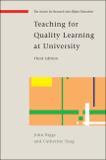| dc.description.abstract | The book is an exceptional introduction to some difficult ideas. It is full of downright good advice for every academic who wants to do something practical to improve his or her students’ learning. So much of what we read on
this subject is either a recycling of sensible advice topped by a thin layer of second-hand theory, or a dense treatise suitable for graduate students with a taste for the tougher courses. Not many writers are able to take the reader
along the middle road, where theory applied with a delicate touch enables us to transform our practice. What is unique about Biggs is his way with words, his outspoken fluency, his precision, his depth of knowledge, his inventiveness, or rather how he blends all these things together. Like all good teachers, he engages us from the start, and he never talks down to us. He achieves unity between his objectives, his teaching methods and his assessment;
and thus, to adapt his own phrase, he entraps the reader in a web of consistency that optimizes his or her own learning.
Perhaps not everyone will agree with Biggs’s treatment of the academic differences between phenomenography and constructivism. I’m not sure I do myself. But does it matter? The author himself takes a pragmatic approach. In the daunting task that faces lecturers in responding to the pressures of mass higher education, reduced public funding, and students who are paying more for their education, the bottom line of engineering better learning outcomes matters more than nice theoretical distinctions.
Readers of the present book will especially enjoy its marvellous treatment of student assessment (particularly Chapters 3, 8 and 9).* Biggs’s most outstanding single contribution to education has been the creation of the Structure of the Observed Learning Outcome (SOLO) taxonomy. Rather than read about the extraordinary practical utility of this device in secondary sources, get it from the original here. From assessing clinical decision making by medical students to classifying the outcomes of essays in history, SOLO remains the assessment apparatus of choice. | en_US |





